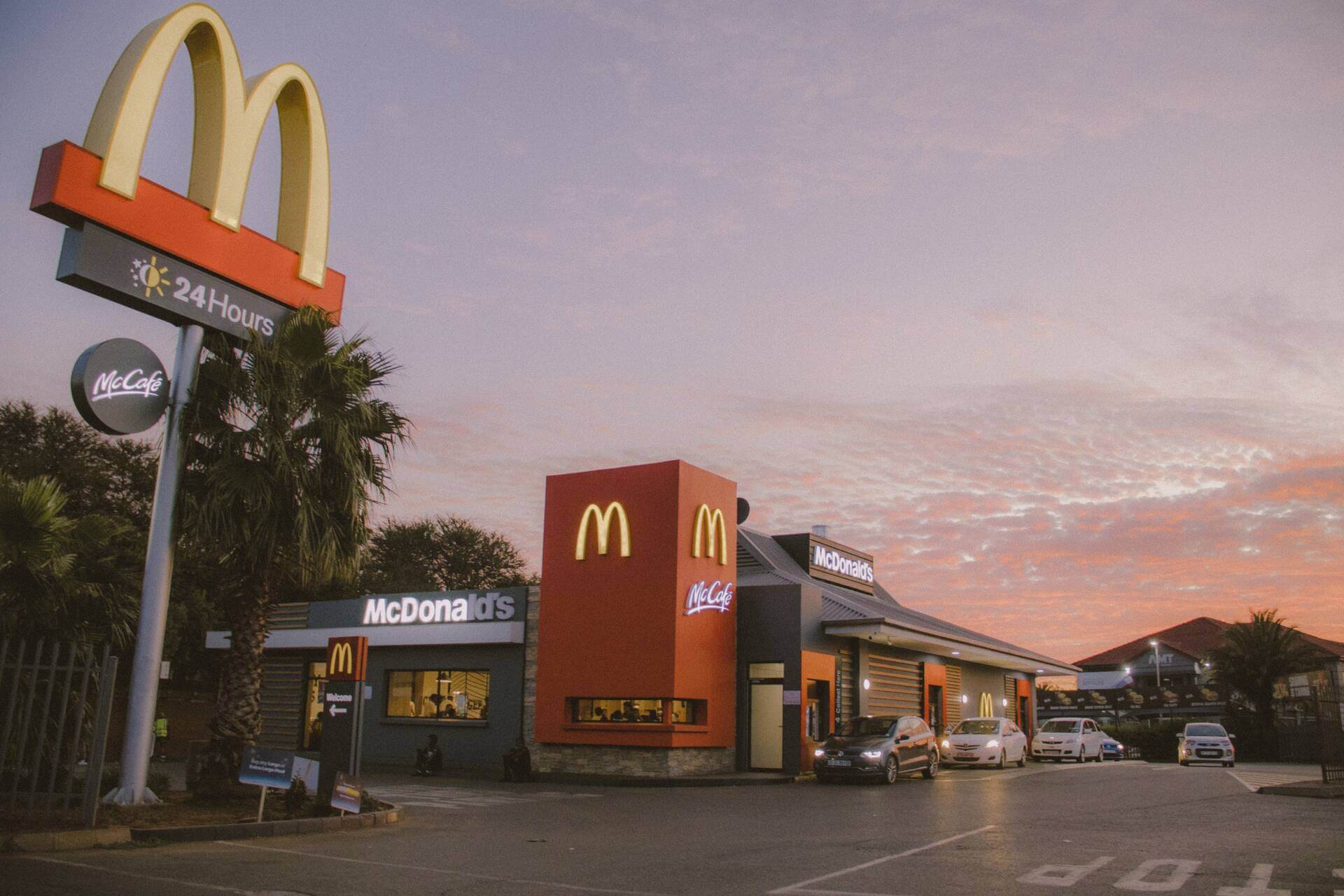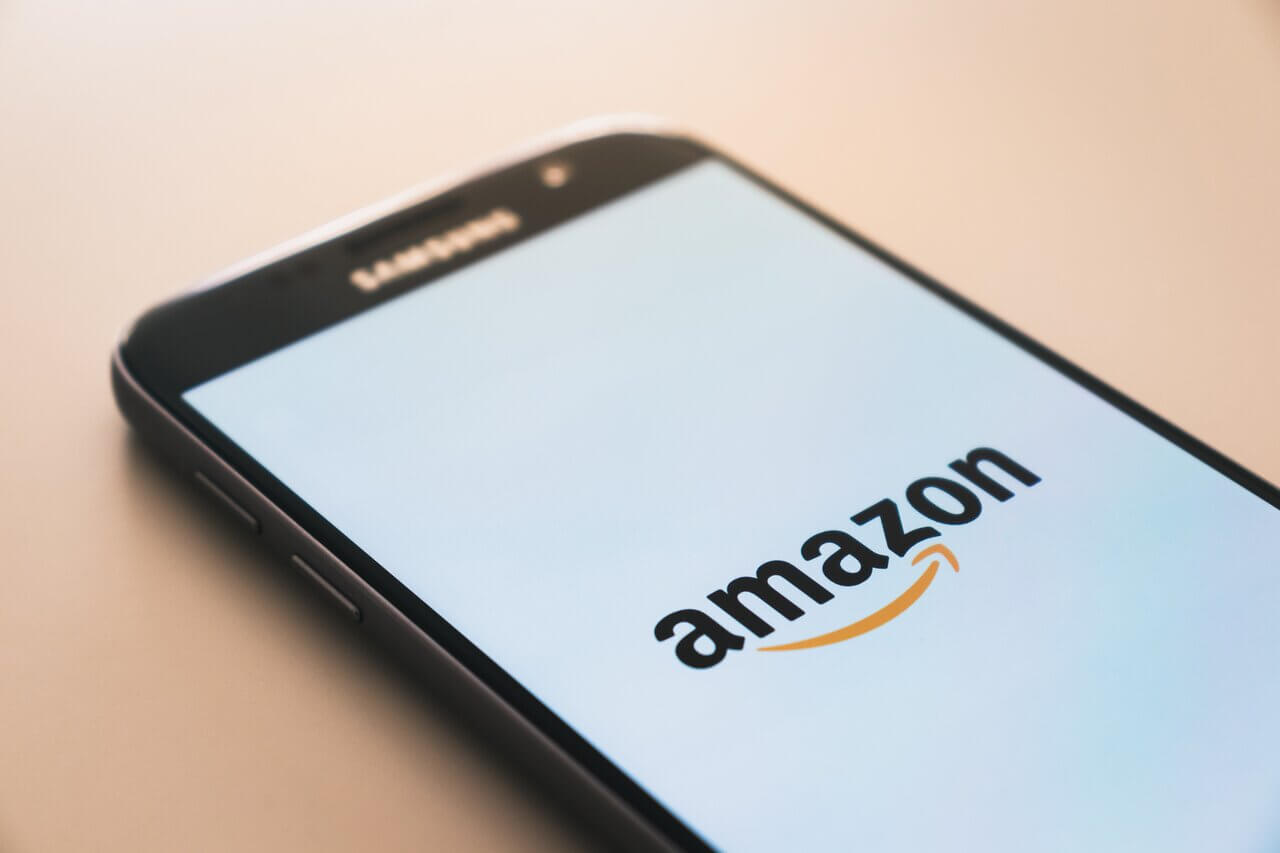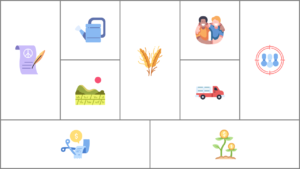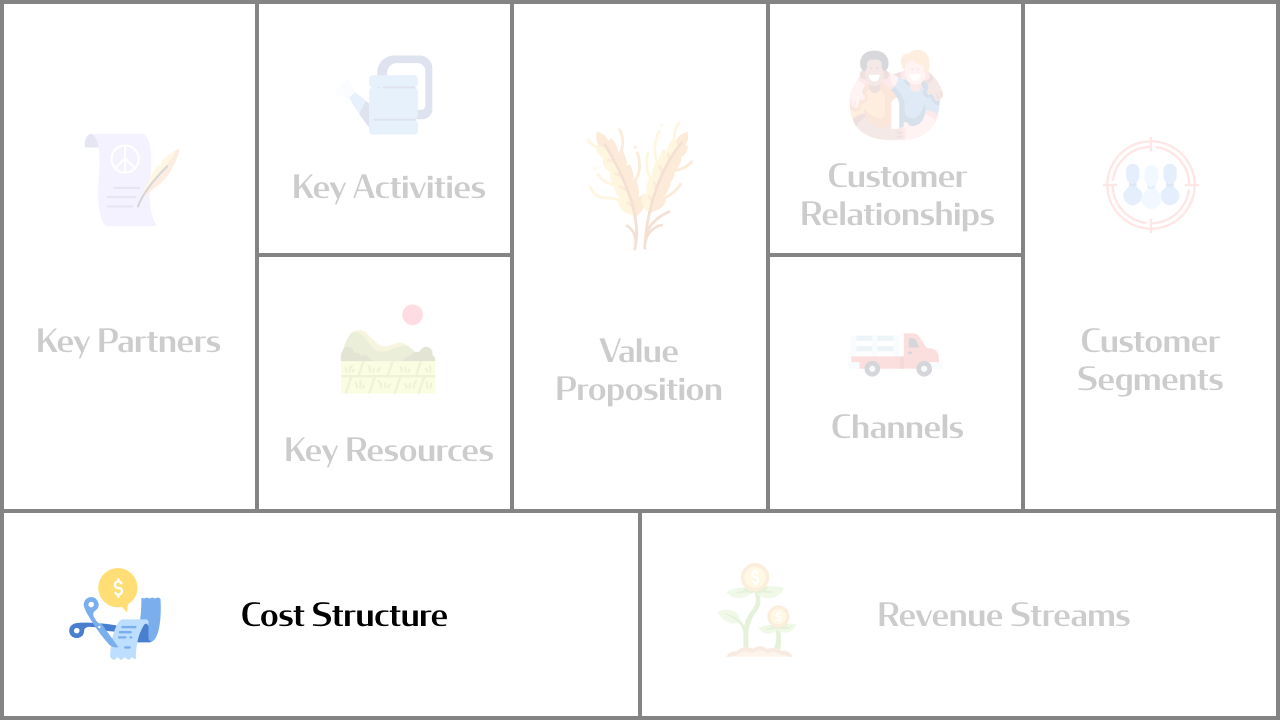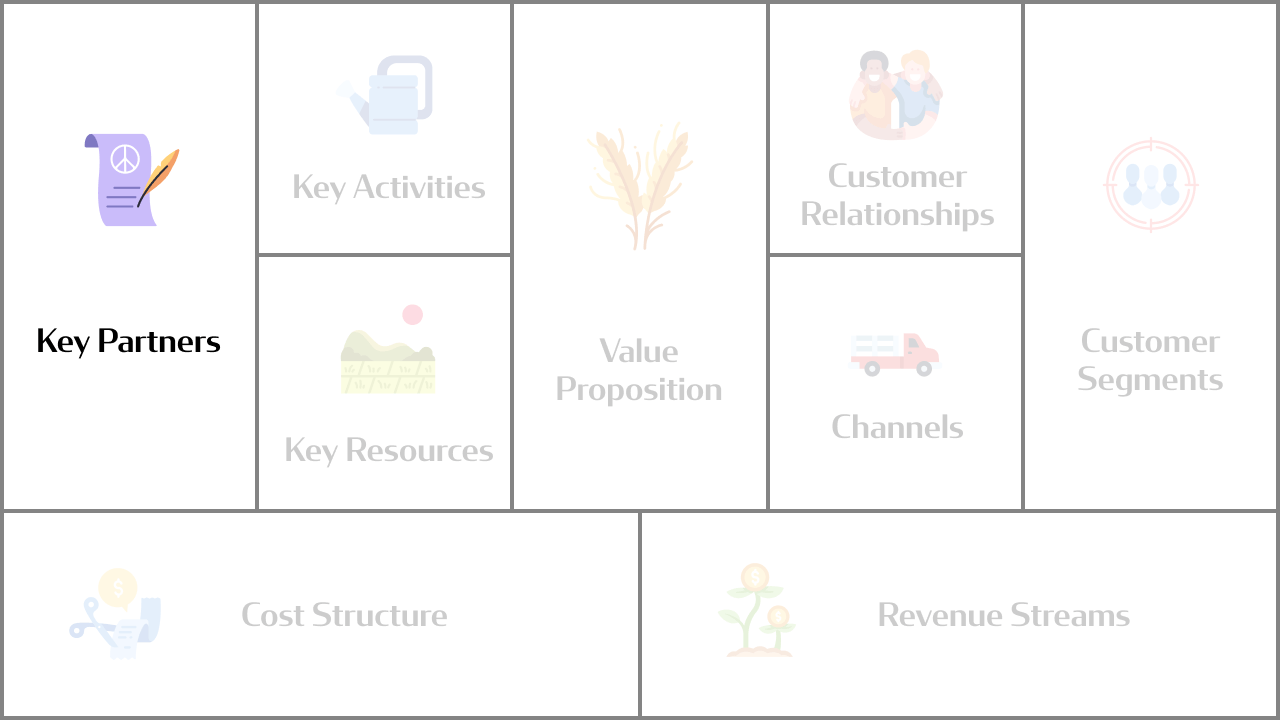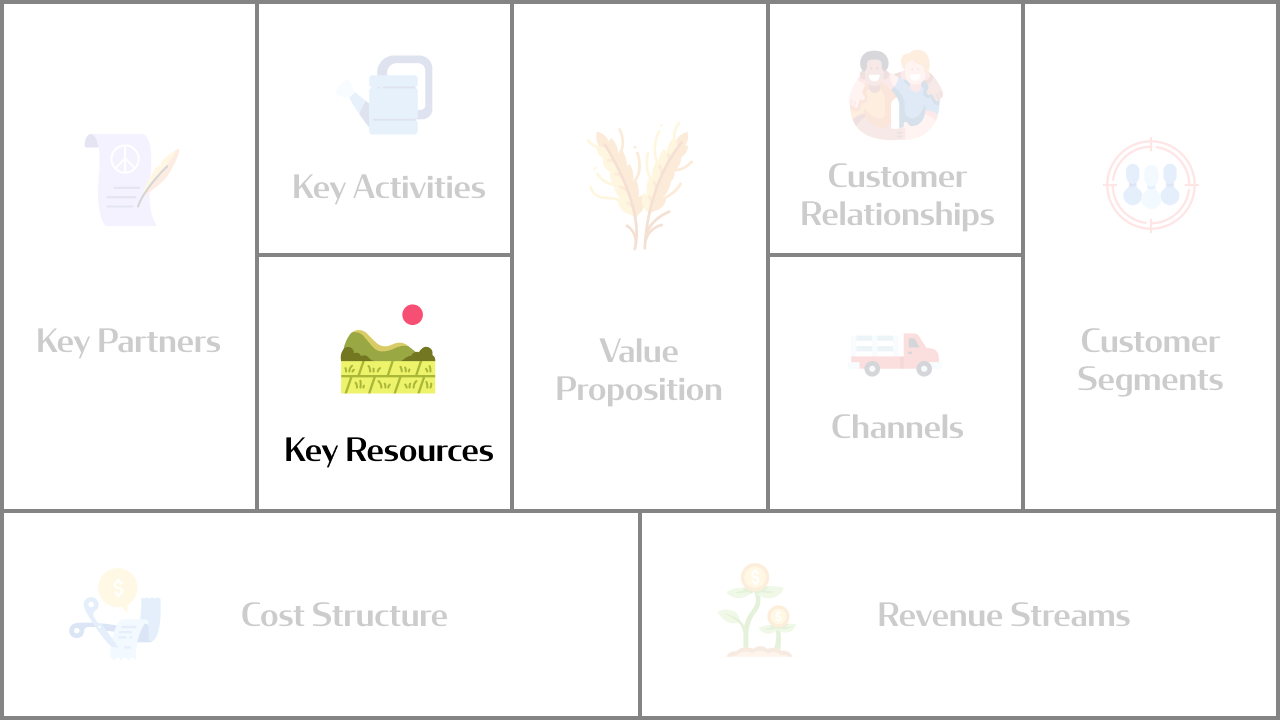Today, Twitter is one of the most recognizable and influential social media platforms on the planet. As of February 2022, Twitter is valued at $27.48 billion and has more than 217 million monetizable daily active users.
New information breaks out on the platform faster than any other site. According to recent stats, roughly 500 million tweets are sent every day on average.
But how did it get here?
In this article, we’re going to take a look at how a simple idea for a new information platform turned into one of the most lucrative and profitable social media sites of the century.
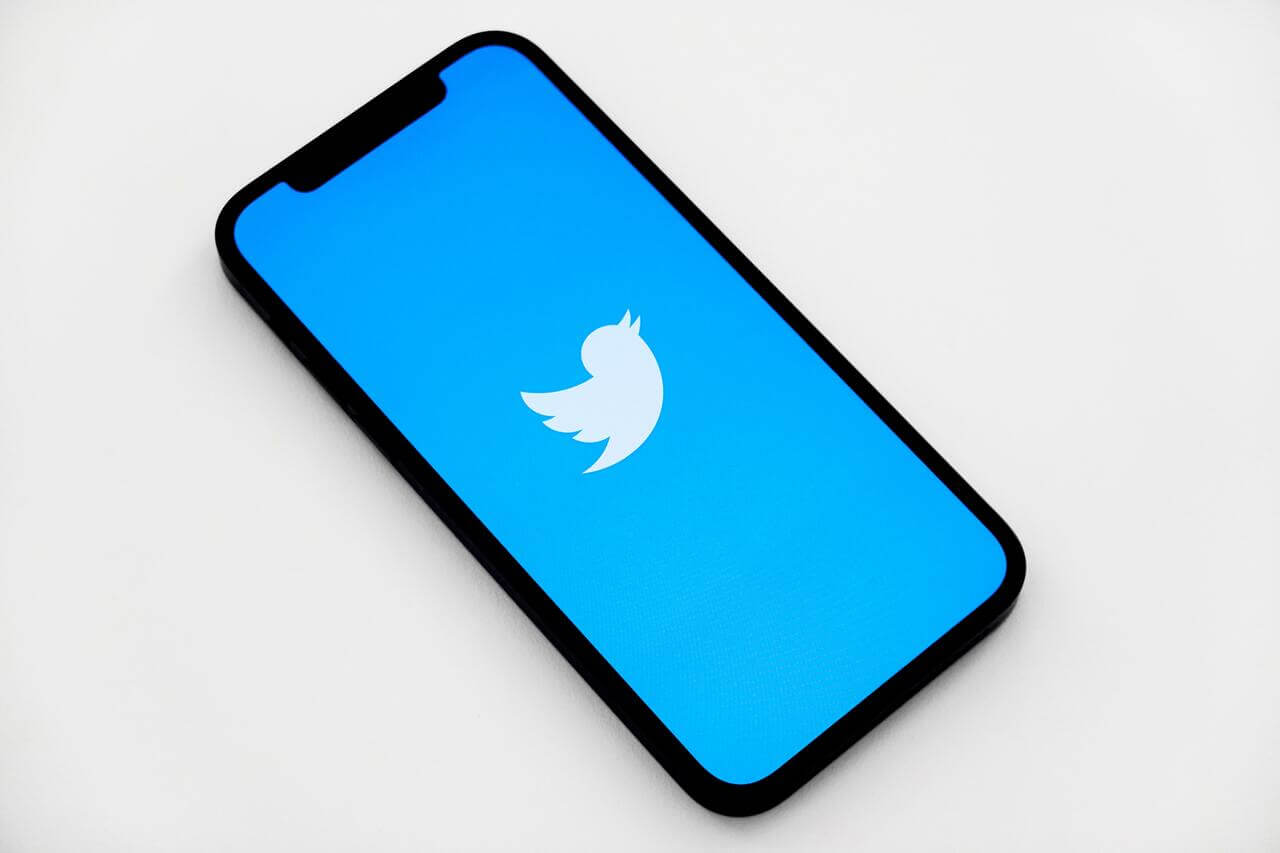
1994-2007: The Creation of Twitter
1994-1999: Jack Dorsey’s Early Career
In the mid-90s, the internet was relatively still a new thing, and many developers and tech professionals were still trying to figure out what they could do on the internet. Jack Dorsey was one of them.
As a teenager, Dorsey used a Macintosh computer and police scanner data to write a graphics program that illustrates vehicles as they move around his home city of St. Louis. Soon, many taxicab drivers in his native St. Louis, Missouri, started using his program.
A few years later, he became interested in bike messenger dispatching software, so he decided to design a program for the process. Dorsey hacks into a New York-based Dispatch Management Services. He points out the security flaw to the company’s chairman, Greg Kidd, who is impressed with Dorsey and asks him to drop out and move to New York to work with him.
Dorsey agrees, takes the job, and later enrolls in NYU to appease his parents. But his stint at NYU lasted only two years, and in 1999 he dropped out to start an online dispatch routing company.
2000-2006: The Twitter Blueprint
In 2000, Dorsey bumped into an early blogging pioneer social platform called LiveJournal. He thought he could improve the site by allowing users to post short, real-time messages/status updates.
Dorsey sketches out Twttr’s idea on a piece of paper and keeps the idea in mind for the next few years. The idea stuck with Dorsey, weaving its way into his dispatch work.
In 2002, Dorsey had a fallout with board members at Dispatch Management Services. He is fired and moves back home. During this time, he comes up with another idea for a chair-massage service for programmers to help with wrist aches, but he soon abandons that idea.
In 2005 after a few years of unsuccessful ideas, Dorsey moved back to San Francisco in a bid to get back into programming. He again approaches Kidd, who agrees to accommodate Dorsey in exchange for babysitting. Dorsey also finds a short-term coding job on Craigslist that allows him to design a more secure online ticketing system for the ferry company that carries tourists to Alcatraz Island.
Meanwhile, Evan Williams, a Silicon Valley celebrity, sold his last startup called Blogger to Google. Williams was looking for a new venture, so he partnered with his neighbor Noah Glass. The two started working on a platform supporting what they saw as the new radio, podcasting.
Williams also roped in one of his co-workers and friends, Biz Stone, to start working on the podcasting platform they called Odeo.
One day, a chance encounter in a coffee shop led to Jack Dorsey joining Odeo. Dorsey was in a coffee shop, writing basic code for the ticketing company he was working for. When Evan Williams walked in, Dorsey recognized him immediately. Dorsey found William’s email online and sent over his resume. After a few conversations and one interview, Dorsey was hired.
Despite the hype surrounding Odeo, the platform performed poorly due to timing, quality, and the increasing tension between the reserved and slow-moving leadership style of Evan Williams and the loud leadership style of Noah Glass. The nail in the coffin was launching a podcasting service on Apple’s juggernaut streaming service iTunes.
2006: The Creation of Twttr
Williams, who was the CEO of the now-defunct Odeo, decided to hold a hackathon to develop a new direction for the company. Jack Dorsey came up with an idea of a social networking site based on a person’s “status.”
Noah Glass, Dorsey, and German programmer Florian Weber started working on a prototype. They were done in two weeks. Glass chose the name Twitter out of the dictionary. Still, Odeo management stylized it as Twttr borrowing from Flickr’s spelling.
On the 21st of March 2006 at 12:50PM, Dorsey sent out the first public tweet: “just setting up my twttr.” And 12 minutes later, he adds, “inviting co-workers.” While the project picked up steam, many of Odeo’s investors were not too keen on the direction the company was taking, so Willams offered to buy them out, and many took the deal. In July 2006, the service was officially unveiled to the public.
Dorsey then partnered with Stone and board members Evan Williams and Noah Glass to launch Obvious Corporation in October 2006. This new company purchased Odeo and renamed the company Twitter.
The first scandal for the company happened a few weeks later when Williams and the board decided to fire Noah Glass, who was dealing with a few personal problems. Glass had been an essential part of developing the Twttr platform. His untimely departure put the first dent in the reputation of Twitter’s management.
2007: Jack Dorsey Becomes Twitter CEO
The tipping point for Twitter was during the 2007 South by Southwest Interactive (SXSWi) conference. During the event, Twitter users grew from 20,000 tweets per day to 60,000. This was due to some genius marketing from Twitter.
During the event, Twitter placed two 60-inch plasma screens in the conference hallways, where they streamed Twitter messages in real-time. Hundreds of conference attendees were able to keep tabs on each other via the platform. This made panelists at the conference take notice, and they mentioned the service. Bloggers also took notice and started writing about the platform.
By the end of the first quarter of 2007, the platform had over 400,000 tweets. This led Obvious Corporation, the holding company created by Williams, Dorsey, and Biz Stone, to set up Twitter as its own startup with Dorsey as its CEO. In June, a few months later, Twitter received a $5 million Series A investment round led by Fred Wilson of Union Square Ventures, leading to a valuation of $20 million.
Two months later, the company released the iconic hashtag (#), which would soon become synonymous with the use of the platform. It was clear that Twitter was slowly gaining traction, and by the end of the year, the site had over 1,6 million tweets.
Twitter Business Model Canvas: The Early Days
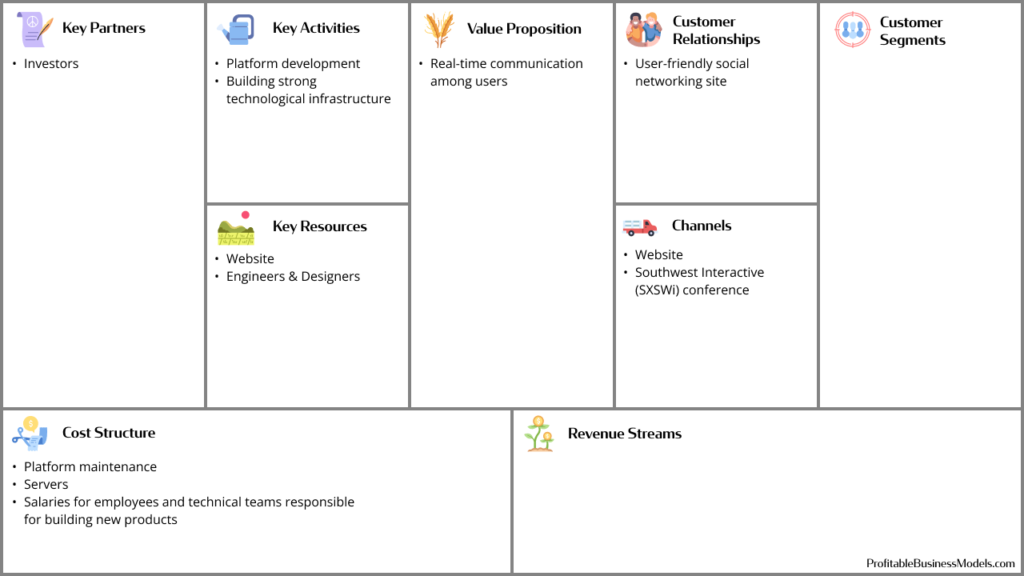
At this point, Twitter’s Business Model Canvas looked like this:
- Real-time communication among users
- User-friendly social networking site
- Website
- Southwest Interactive (SXSWi) conference
- Platform development
- Building strong technological infrastructure
- Website
- Engineers & Designers
- Investors
- Platform maintenance
- Servers
- Salaries for employees and technical teams responsible for building new products
2008-2013: The Road to Becoming A Social Media Giant
2008-2010: Jack Dorsey Is Kicked Out
Things were looking up for Twitter; by March, there were 1 million Twitter users, and a total of 3 million tweets were being sent out every day. The company got a second round of funding, welcoming new investors Bijan Sabet of Spark Capital and Jeff Bezos of Bezos Expeditions. Existing partners Union Square Ventures and Digital Garage also invest more.
However, the somewhat eccentric Dorsey had developed a habit of leaving work early to attend fashion design and yoga classes. At the same time, the platform was experiencing persistent outages that caused the service to crash constantly. Moreover, Dorsey and his team had not yet found a way to back up the entire system, so valuable data was lost every time the platform crashed.
Williams and board members became increasingly frustrated with Dorsey’s carefree attitude and his incapability to deal with the platform outages. In a line that is now famous, Williams told Dorsey, “You can either be a dressmaker or the CEO of Twitter. You can’t be both.”
Things didn’t change, so in October, Williams, with the help of the board, fired Dorsey and took over as CEO. Dorsey remained as a chairman of the board.
The Development of Square & The Beginning of Twitter Advertising
Meanwhile, in 2009, Dorsey got an idea to build a mobile-payment company when his friend Jim McKelvey told him that he is struggling to sell his glass faucets for $2,000 because he has no way to accept credit cards.
Dorsey and McKelvey partner up and start working on the mobile card reader, calling it Square after the phrase “squaring up .”Square takes off, and by 2010, Dorsey plunges deep into his second startup leadership role. He starts emulating Apple co-founder Steve Jobs by dressing and speaking like him.
He even takes it as far as altering the Twitter origin story in interviews, leading to serious public relations issues for Twitter’s board. In fact, Dorsey started telling new board member and investor Peter Fenton that Williams had slighted Dorsey during the CEO handoff.
Advertising & Marketing
Nevertheless, the site continues to grow. In February 2009, Twitter announced the closure of yet another funding round, which included new investors Peter Fenton of Benchmark Capital and Todd Chaffee of Institutional Venture Partners.
To get more publicity for the site, Williams scores a slot on the Oprah Winfrey show alongside Ashton Kutcher to explain how Twitter works to the audience. This marketing strategy worked, and thanks to the Oprah effect, at least 1.2 million people created an account on Twitter.
The company also decided to take their market worldwide and set a team over to Iraq to try and expose the people there to social media and the Internet.
The Journey to Profitability
For all of Twitter’s success in attracting users, one question that Twitter founders were failing to answer consistently was how will it make money? Sure, it could secure funding without a hitch, but Twitter’s revenue remained at zero year after year.
The company managed to secure a bit of revenue in 2009 when they sold the right for its tweets to become viewable on search engines like Bing and Google for $10 and $15 million, respectively. But this was not a consistent model of profitability.
The founders wanted to avoid saturating the site with adverts like Facebook. By the time Williams brought on Costolo, an old friend and colleague from Google Inc, as COO in September of 2009, the Twitter company was already under pressure.
The site was gaining many young users at an unprecedented pace. The company’s co-founders had been splashed across magazine covers as the embodiment of San Francisco cool. Yet Silicon Valley was awash with rumors that Twitter didn’t have the technical capabilities to make the service reliable at a vast scale, and it didn’t have any way to make money.
Williams knew that fixing the site’s notorious technical problems was a top priority. Still, he just wasn’t clear about how to go about it while making the site profitable. For months, Williams weighed options such as:
- Displaying advertising
- Licensing Twitter’s data
- Becoming an e-commerce hub
- Offering paid “commercial” accounts to businesses
Costolo, who had experience running an advertising-based blog publishing service called Feedburner, was clear that paid advertising was the way to go. By his second month on the job, Costolo had persuaded Williams to allow engineering positions to build Twitter’s first ad unit, which would become the “promoted tweet .”This would become the cornerstone of Twitter’s business today.
In April 2010, Twitter started allowing for advertising in the form of promoted tweets. This trial run was launched with five brands, including Starbucks Corp and Virgin America. Unfortunately, it was not successful as users rarely saw the ads.
Still, Costolo was confident enough in his concept that he began seeking marketing execs to join the team. He tried to persuade Adam Bain, a rising star at News Corp, to join the Twitter ad department for months. He also courted other marketers, ranging from corner suites on Madison Avenue to industry conferences on the French Riviera.
Fortunately, Bain agreed, and under his leadership, the Twitter ad team set its sights on the most lucrative advertising market of all – television. Twitter launched on the big screen by branding itself to TV programmers and prominent brand marketers as an online peanut gallery where TV viewers could discuss what they were watching.
The hashtag character soon grew in popularity as users created conversations around what they watched on Twitter. Soon the platform became a popular and constant platform for Super Bowl commercials, Nascar races, and Oscars red carpet.
It wasn’t easy for the company to persuade businesses and users to buy content on Twitter until the brand positioned itself as a companion to TV programs.
Later on that year, the first unassisted off-Earth Twitter message was posted from the International Space Station by NASA astronaut T. J. Creamer, ensuring more publicity for the platform.
To cater to the growing user base, Twitter began rolling out an entirely revamped edition of twitter.com. Changes to the site included the ability to see pictures and videos without using a third-party site, as well as a complete overhaul of the interface to make it more user-friendly. For example, links such as ‘@mentions’ and ‘Retweets’ could now be found above the Twitter stream. At the same time, ‘Messages’ and ‘Log Out’ became accessible via a black bar at the very top of the site.
2011-2012: The Return of Jack Dorsey
Dorsey’s efforts to undermine Williams finally succeeded, and in October 2010, the company’s board replaced Williams with then-COO Dick Costolo. The reason for William’s exit was cited as an inability to manage the site’s growth, increase investor returns, and build out a more experienced executive team.
Dorsey was asked to come back in April 2011 as executive chairman, focusing on product development. This meant that his time was spent between Twitter and Square. In July 2011, Twitter received significant publicity when then sitting president Barack Obama agreed to co-host a meeting with Dorsey at Twitter Town Hall.
In September 2011, Twitter closed off its Series G round after raising $800 million at an $8 billion valuation. This allows the company to keep the site running. They shut off the year with a platform overhaul that makes it easier for new users to follow and promote advertising.
Some Key Partnerships & Acquisitions
By its sixth anniversary in March 2012, Twitter had amassed 140 million users and 340 million tweets per day. The following month in April, the company announced that it was opening an office in Detroit. This new site aimed to partner with automotive brands and advertising agencies to increase ad revenue. Twitter also expanded its office in Dublin.
A few months later, in October, Twitter acquired a video clip company called Vine that launched in January 2013. While Vine was a standalone app that allowed users to create and share six-second looping video clips, the sites were intricately linked. Vine videos could be shared and viewed directly on a users’ Twitter feeds. By December, Twitter had surpassed 200 million monthly active users; it was time to go public.
2013: Going Public
In September 2013, Twitter filed its IPO. They announced the news to the public in a tweet. In November, the IPO raised $1.8 billion, giving it a market value of $31 billion. The company had finally become a social media giant.
Twitter Business Model Canvas: Becoming A Social Media Giant
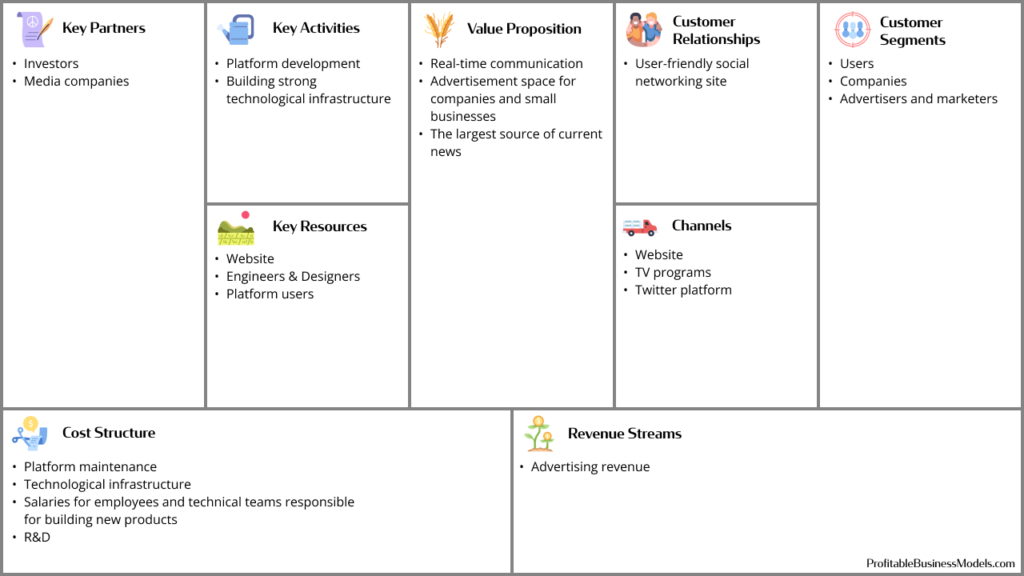
At this point, Twitter’s Business Model Canvas looked like this:
- Real-time communication
- Advertisement space for companies and small businesses
- The largest source of current news
- Users
- Companies
- Advertisers and marketers
- User-friendly social networking site
- Website
- TV programs
- Twitter platform
- Advertising revenue
- Platform development
- Building strong technological infrastructure
- Website
- Engineers & Designers
- Platform users
- Investors
- Media companies
- Platform maintenance
- Technological infrastructure
- Salaries for employees and technical teams responsible for building new products
- R&D
Conclusion: Twitter —A Global Information Hub
While the IPO in 2013 went well, the following period was not so rosy for the social media giant. In fact, the next few years were filled with news of uncertain growth, slumping share prices, and an inability of management to refine the company’s long-term vision.
As a result, Costolo resigned from his CEO role at Twitter in July 2015, and Dorsey took over. Twitter continued to develop its site, launching several platform upgrades and tweaks to keep up with changing customer demands and technology.
The company also acquired several startups whose technology was integrated into the Twitter software to continue providing optimal services.
Thanks to the ingenuity of Costolo, Twitter has positioned itself as a global information hub for current and trending news; only time will tell if Twitter can maintain profitability.
Sources
- https://www.macrotrends.net/stocks/charts/TWTR/twitter/net-worth#:~:text=Twitter%20net%20worth%20as%20of%20February%2018%2C%202022%20is%20%2427.48B.
- https://www.omnicoreagency.com/twitter-statistics/#:~:text=1.,Twitter%20(Twitter%2C%202022).
- https://www.forbes.com/sites/christianwolan/2011/04/14/the-real-story-of-twitter/?sh=53ec3a6d66af
- https://www.theverge.com/2015/10/5/9457277/jack-dorsey-twitter-ceo-timeline
- https://techcrunch.com/2008/04/29/end-of-speculation-the-real-twitter-usage-numbers/
- https://techcrunch.com/2009/04/20/how-many-new-twitter-users-post-oprah-a-lot-maybe-over-a-million/
- https://www.businessinsider.com/history-of-twitter-2013-9?IR=T
- https://www.britannica.com/topic/Twitter

